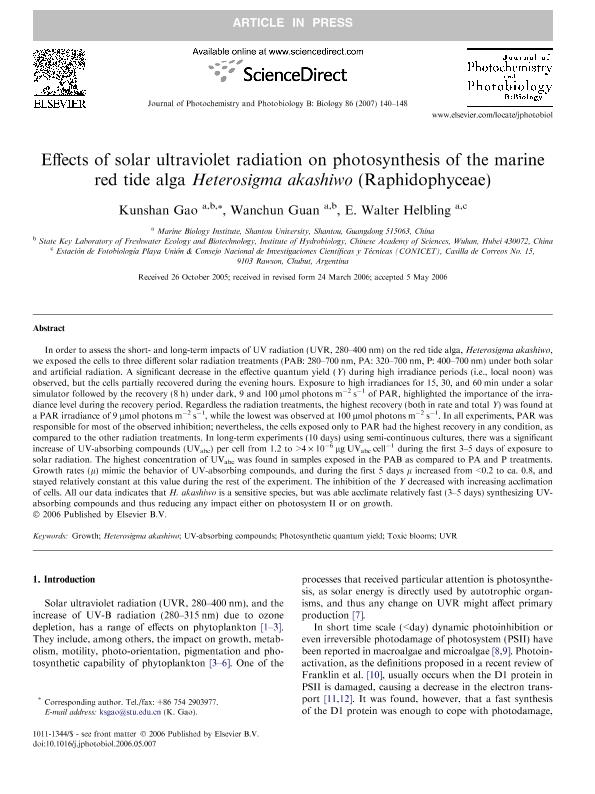Mostrar el registro sencillo del ítem
dc.contributor.author
Gao, Kunshan
dc.contributor.author
Guan, Wanchun
dc.contributor.author
Helbling, Eduardo Walter

dc.date.available
2020-04-07T17:45:34Z
dc.date.issued
2007-02
dc.identifier.citation
Gao, Kunshan; Guan, Wanchun; Helbling, Eduardo Walter; Effects of solar ultraviolet radiation on photosynthesis of the marine red tide alga Heterosigma akashiwo (Raphidophyceae); Elsevier Science Sa; Journal of Photochemistry and Photobiology B: Biology; 86; 2; 2-2007; 140-148
dc.identifier.issn
1011-1344
dc.identifier.uri
http://hdl.handle.net/11336/102186
dc.description.abstract
In order to assess the short- and long-term impacts of UV radiation (UVR, 280–400 nm) on the red tide alga, Heterosigma akashiwo, we exposed the cells to three different solar radiation treatments (PAB: 280–700 nm, PA: 320–700 nm, P: 400–700 nm) under both solar and artificial radiation. A significant decrease in the effective quantum yield (Y) during high irradiance periods (i.e., local noon) was observed, but the cells partially recovered during the evening hours. Exposure to high irradiances for 15, 30, and 60 min under a solar simulator followed by the recovery (8 h) under dark, 9 and 100 lmol photons m2 s1 of PAR, highlighted the importance of the irradiance level during the recovery period. Regardless the radiation treatments, the highest recovery (both in rate and total Y) was found at a PAR irradiance of 9 lmol photons m2 s1, while the lowest was observed at 100 lmol photons m2 s1. In all experiments, PAR was responsible for most of the observed inhibition; nevertheless, the cells exposed only to PAR had the highest recovery in any condition, as compared to the other radiation treatments. In long-term experiments (10 days) using semi-continuous cultures, there was a significant increase of UV-absorbing compounds (UVabc) per cell from 1.2 to >4 · 106 lg UVabc cell1 during the first 3–5 days of exposure to solar radiation. The highest concentration of UVabc was found in samples exposed in the PAB as compared to PA and P treatments. Growth rates (l) mimic the behavior of UV-absorbing compounds, and during the first 5 days l increased from <0.2 to ca. 0.8, and stayed relatively constant at this value during the rest of the experiment. The inhibition of the Y decreased with increasing acclimation of cells. All our data indicates that H. akashiwo is a sensitive species, but was able acclimate relatively fast (3–5 days) synthesizing UVabsorbing compounds and thus reducing any impact either on photosystem II or on growth.
dc.format
application/pdf
dc.language.iso
eng
dc.publisher
Elsevier Science Sa

dc.rights
info:eu-repo/semantics/openAccess
dc.rights.uri
https://creativecommons.org/licenses/by-nc-sa/2.5/ar/
dc.subject
Growth
dc.subject
Heterosigma akashiwo
dc.subject
UV-absorbing compounds
dc.subject
Photosynthetic quantum yield
dc.subject
Toxic blooms
dc.subject
UVR
dc.subject.classification
Otros Tópicos Biológicos

dc.subject.classification
Ciencias Biológicas

dc.subject.classification
CIENCIAS NATURALES Y EXACTAS

dc.title
Effects of solar ultraviolet radiation on photosynthesis of the marine red tide alga Heterosigma akashiwo (Raphidophyceae)
dc.type
info:eu-repo/semantics/article
dc.type
info:ar-repo/semantics/artículo
dc.type
info:eu-repo/semantics/publishedVersion
dc.date.updated
2020-04-06T16:12:25Z
dc.journal.volume
86
dc.journal.number
2
dc.journal.pagination
140-148
dc.journal.pais
Países Bajos

dc.journal.ciudad
Amsterdam
dc.description.fil
Fil: Gao, Kunshan. Shantou University; China. Institute of Hydrobiology; China
dc.description.fil
Fil: Guan, Wanchun. Institute of Hydrobiology; China. Shantou University; China
dc.description.fil
Fil: Helbling, Eduardo Walter. Consejo Nacional de Investigaciones Científicas y Técnicas; Argentina. Fundación Playa Unión. Estación de Fotobiología Playa Unión; Argentina
dc.journal.title
Journal of Photochemistry and Photobiology B: Biology

dc.relation.alternativeid
info:eu-repo/semantics/altIdentifier/url/https://www.sciencedirect.com/science/article/abs/pii/S1011134406001369
dc.relation.alternativeid
info:eu-repo/semantics/altIdentifier/doi/http://dx.doi.org/10.1016/j.jphotobiol.2006.05.007
Archivos asociados
